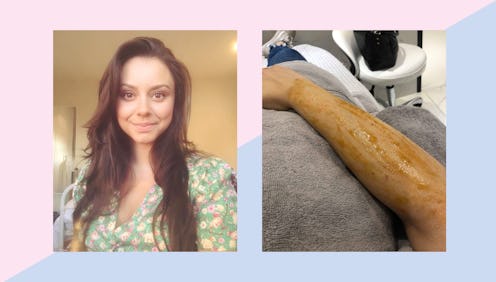Style
I've Had Keratosis Pilaris My Entire Life & These Are The Treatments That Work

For the last year of my life, I have been hunting high and low, trying treatments, and consulting experts for a cure for my Keratosis Pilaris. My arms have made me self-conscious my whole life with remarks from people asking, "What’s wrong with your skin?" and, "Is that contagious?" while moving their chairs further away.
If you’ve ever experienced Keratosis Pilaris (KP), you’ll know how frustrating this skin condition is. Those annoying red bumps that plague your arms, thighs or bum can be really tricky to deal with as there’s actually no definitive cure. Sorry to be the one to break that news to you, but it’s best to get that information straight off the bat, don’t you think? Treatment will be a case of trial and error and what may work for some, may not work for others. But, as someone who really suffers with this condition, I hope I can share some knowledge and experience in lessening its impact on your life.
What is Keratosis Pilaris?
According to dermatologist Dr Christopher Rowland Payne KP occurs "exclusively in people that are atopic." It’s caused by the skin overproducing keratin, the hard protein found in hair and nails, which combines with dead skin cells to block the hair follicles causing red, raised bumps, or 'plugs.'
How do I treat Keratosis Pilaris?
I paid a visit to Mortar & Milk, an expert skin treatment clinic in London, to see if clinical aesthetician Pamela Marshall could share some insight. She suggested exfoliating weekly, either with a gentle dry brush or using a glycolic acid body treatment, explaining that "lycolic acid forces cell turnover while polyhydroxy acids calm and hydrate our skin." She continued: "Most importantly, do not pick at the skin or over exfoliate as this can aggravate the condition. Always remember that keeping the skin hydrated with a good moisturiser is the most effective method. It will take a while to see results, but your skin should start to calm down."
The key to dealing with KP is consistency. If your routine stops, the build-up of keratin returns and, unfortunately, so do the dreaded bumps. This is probably the most disheartening part of this condition, so when you see progress — keep going!
What products should I buy?
After trialling products for the last 10 years of my life, I’ve rounded up the only ones that are worth your money and make a noticeable difference to the appearance and texture of persistent KP.
Is there anything else can I do?
As well as tackling my KP at home, I also paid a visit to the Therapie Clinic in London to see if a professional treatment could help. If you are too lazy to stick to an at-home regimen, this is the way to go. We started with a thorough cleanse of my arms and after that, a personalised treatment began. A papaya enzyme peel (£100) was applied which was tingly but not uncomfortable, it exfoliated my skin to a deeper, stronger level than any product you can buy over the counter. Another cleanse ensued followed by hyaluronic acid serum to rehydrate.
Lastly, I was given some LED light therapy. Red light improves collagen synthesis, stimulating cell repair, and blue light will kill bacteria. Orange light will soothe inflammation and redness. My therapist tried a mixture of all three (hence the pink light in the photo below).
While I was pleasantly surprised by how soft this treatment left my skin, it needs to be done every two weeks so you’d need regular appointments for a few months to see a change, making it an expensive option.
The verdict...
I’ve definitely seen an improvement in my KP during a year of trialing these treatments and I have learned that persistence is paramount. Consistently using a regime that works for you will make a huge difference but, please don’t feel downhearted about the appearance of your skin, it will get better. Trust me.